#(mid 1800s clothing)
Text
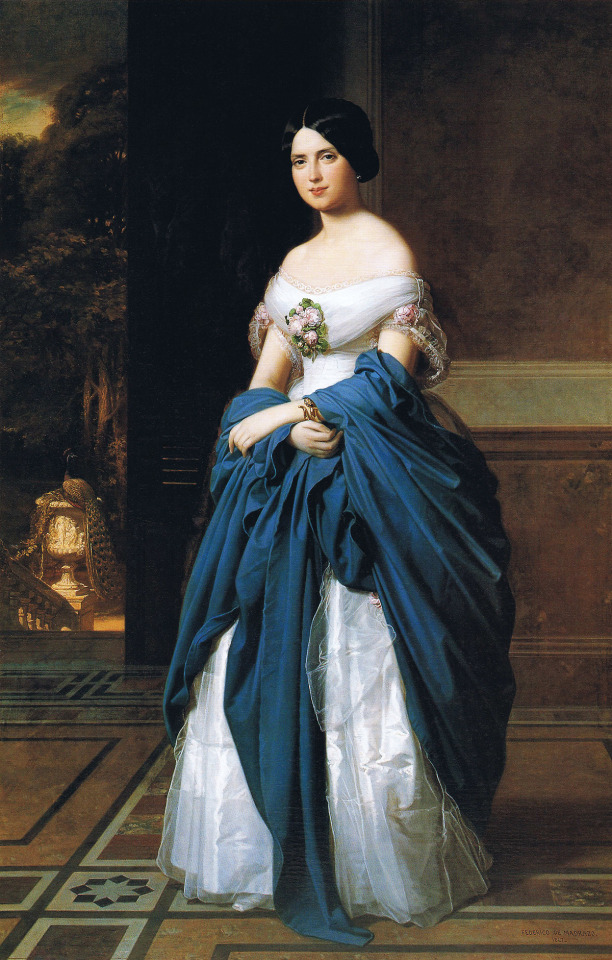
Federico de Madrazo y Kuntz (1815-1894)
"Leocadia Zamora y Quesada" (1847)
#paintings#art#artwork#genre painting#female portrait#frederico de madrazo y kuntz#fine art#spanish artist#portrait of a woman#white dress#dresses#clothing#clothes#blue#pretty#aesthetic#aesthetics#dark hair#1840s#mid 1800s#mid 19th century#1k#2k
2K notes
·
View notes
Text
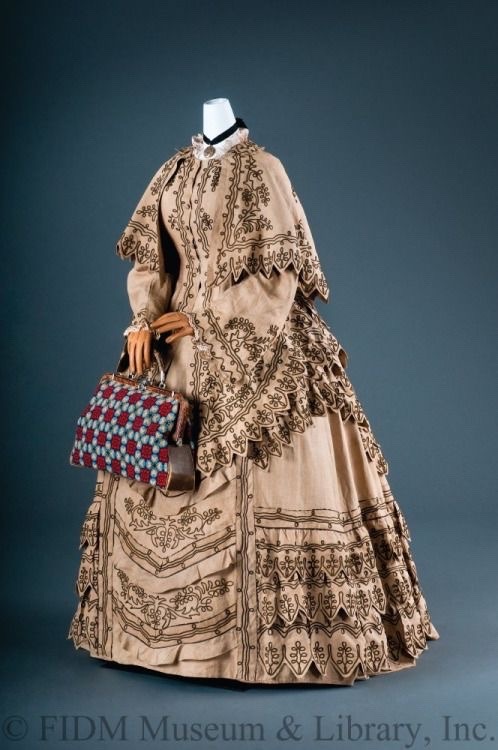
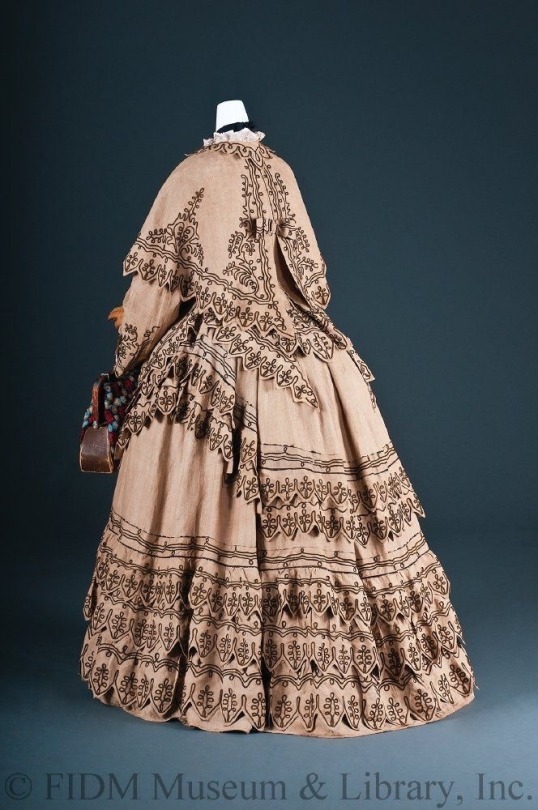
Day Dress- 1870-74
#fashion#historical#historical fashion#victorian#victorian era#victorian fashion#historical clothing#historical dress#history#long dress#the gilded age#1870s fashion#1800s dress#mid 1800s#1800s#19th century fashion#fashion dress#high fashion#victorian dress#dresses#dress#victorian history#victorian clothing#historical outfits#art#artwork#19th century#19th century clothing#historical 19th century#day dress
375 notes
·
View notes
Text
felling the lining on my test-run waistcoat (by hand, as usual) and feeling as though this will take up the remainder of my natural life
#sewing projects#I think a lot about the many women employed in the mid-1800s pre-sewing-machine readymade clothing industry#and shudder to imagine doing this for like 5 cents per vest instead of for fun
2 notes
·
View notes
Text
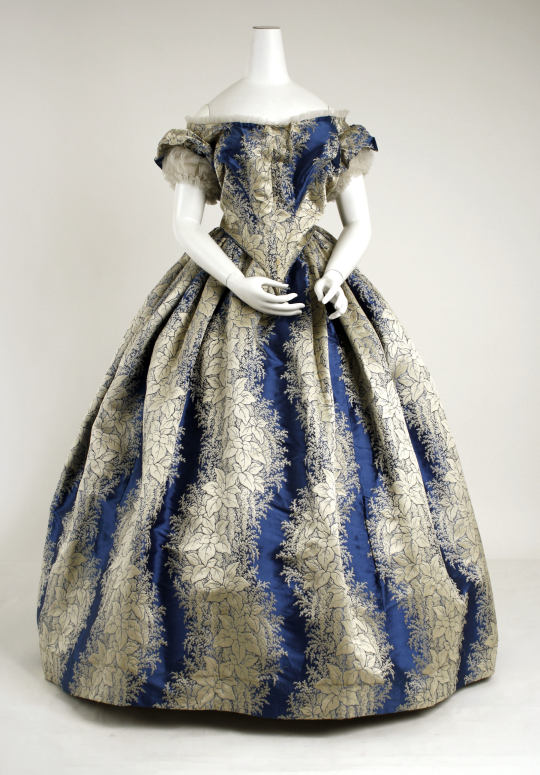

#fashion#vintage clothing#ball gown#evening dress#dress#1800s#mid 1800s#19th century#19th century fashion#blue dress#beautiful#elegant#elegance#american#american fashion
6 notes
·
View notes
Text
my toxic trait is that i saw a “fun fact” on a girl’s profile in a dating app, went this doesn’t fucking sound true, and spent over half an hour hunting through primary sources linked on wikipedia and learning the etymology and history of word-usage just to prove the very specific and meaningless thing she said was false and then tell her that through the dating app. she’s not even my type
#she claimed the reason we call trains ‘trains’ is because they’re named after George Train#who ran a prominent railway company in the mid-1800s#but not only is the earliest usage of the word train to refer to locomotives 4 years before train’s birth#(according to merriam webster)#but the usage of the word train to refer to a series of units being pulled along a path#actually dates back to referring to soldiers animals and wagons potentially as far back as middle english#meaning that it’s entirely possible that when the first gravity driven wagon rails were invented in the 1500s#that people were calling those shits trains too#because they were pulled. by trains of horses#train comes from an old medieval french verb meaning to draw or pull#it was used to describe things pulled along in linked succession long before steam locomotives existed#the idea that we could ever possibly attribute the naming of trains to one failed presidential candidate#who ISNT EVEN LINKED on the wikipedia’s history of trains page#is fucking preposterous. and frankly this person really should have fucking sensed that#like how do you hear a fact like that and just believe it whole cloth#you should have the sense. to know that we use the word train for other things#it’d be fucking insane if that man invented an extremely common use word and was never taught about in schools#like. what the fuck. that’s so intuitively misinformation#but you’re still???? sharing it?????? why?????#oc#if a girl was 100% my type and i really liked her and then she confidently shared this misinfo with me#it would like. sour my attraction to her a little bit
7 notes
·
View notes
Text
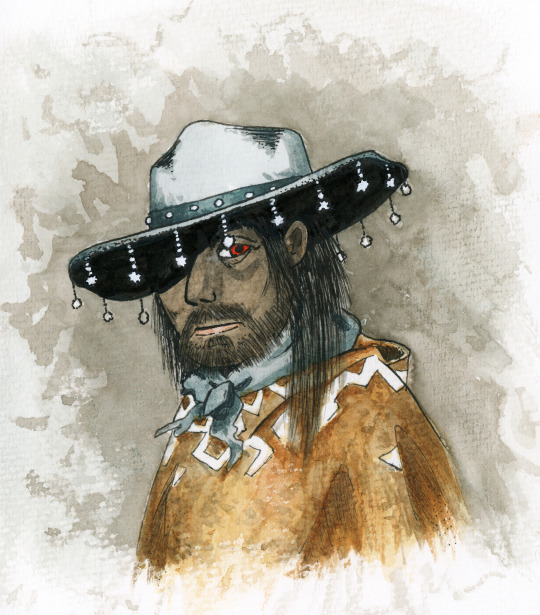
New boy, this is Camilo
#my art#he's a vampire cowboy#kinda sorta#anyways he's angsty bc he can be#I had to give him a hat inspired by hateful eight and that clint eastwood poncho#yes i love westerns deal with it#i also love irl western history#well i love learning about it#i dont love a lot of what happened but thats because it mostly ping pongs between being racist against mexicans native americans etc#this has been history ramblings with hk#tune in next time to hear a different hyperfixation#(mid 1800s clothing)
0 notes
Text
PSA to all historical fiction/fantasy writers:
A SEAMSTRESS, in a historical sense, is someone whose job is sewing. Just sewing. The main skill involved here is going to be putting the needle into an out of the fabric. They’re usually considered unskilled workers, because everyone can sew, right? (Note: yes, just about everyone could sew historically. And I mean everyone.) They’re usually going to be making either clothes that aren’t fitted (like shirts or shifts or petticoats) or things more along the lines of linens (bedsheets, handkerchiefs, napkins, ect.). Now, a decent number of people would make these things at home, especially in more rural areas, since they don’t take a ton of practice, but they’re also often available ready-made so it’s not an uncommon job. Nowadays it just means someone whose job is to sew things in general, but this was not the case historically. Calling a dressmaker a seamstress would be like asking a portrait painter to paint your house
A DRESSMAKER (or mantua maker before the early 1800s) makes clothing though the skill of draping (which is when you don’t use as many patterns and more drape the fabric over the person’s body to fit it and pin from there (although they did start using more patterns in the early 19th century). They’re usually going to work exclusively for women, since menswear is rarely made through this method (could be different in a fantasy world though). Sometimes you also see them called “gown makers”, especially if they were men (like tailors advertising that that could do both. Mantua-maker was a very feminized term, like seamstress. You wouldn’t really call a man that historically). This is a pretty new trade; it only really sprung up in the later 1600s, when the mantua dress came into fashion (hence the name).
TAILORS make clothing by using the method of patterning: they take measurements and use those measurements to draw out a 2D pattern that is then sewed up into the 3D item of clothing (unlike the dressmakers, who drape the item as a 3D piece of clothing originally). They usually did menswear, but also plenty of pieces of womenswear, especially things made similarly to menswear: riding habits, overcoats, the like. Before the dressmaking trade split off (for very interesting reason I suggest looking into. Basically new fashion required new methods that tailors thought were beneath them), tailors made everyone’s clothes. And also it was not uncommon for them to alter clothes (dressmakers did this too). Staymakers are a sort of subsect of tailors that made corsets or stays (which are made with tailoring methods but most of the time in urban areas a staymaker could find enough work so just do stays, although most tailors could and would make them).
Tailors and dressmakers are both skilled workers. Those aren’t skills that most people could do at home. Fitted things like dresses and jackets and things would probably be made professionally and for the wearer even by the working class (with some exceptions of course). Making all clothes at home didn’t really become a thing until the mid Victorian era.
And then of course there are other trades that involve the skill of sewing, such as millinery (not just hats, historically they did all kinds of women’s accessories), trimming for hatmaking (putting on the hat and and binding and things), glovemaking (self explanatory) and such.
TLDR: seamstress, dressmaker, and tailor are three very different jobs with different skills and levels of prestige. Don’t use them interchangeably and for the love of all that is holy please don’t call someone a seamstress when they’re a dressmaker
#sewing#historical sewing#sewing knowledge#writing guide#PSA to writers#historical fiction#fantasy writing
679 notes
·
View notes
Text
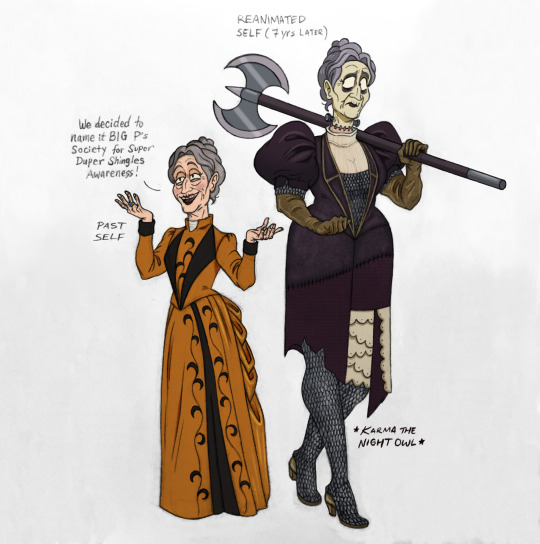
Here's how I imagine Lady Elizabeth Godwin when she was alive compared to her reanimated self. I was inspired by MANY different visual ideas and concepts like the original Frankenstein book, late 1880s strongwomen, and 1890s fashion.
Here was my aesthetic mood board!
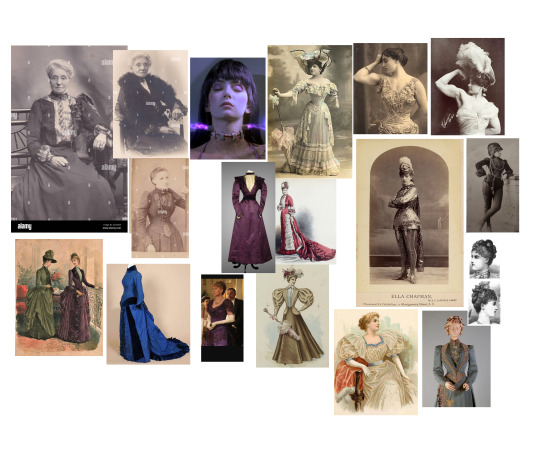
Since the og Frankenstein book describes the flesh of the creature to be yellow and translucent, rather than the popular green flesh seen in most film adaptations, I applied the former to Godwin's flesh of her head. Plus I wanted to really go for that corpse like appearance, particularly with the hollowness of her eyes.
The outfit she wore on the night of her passing was inspired by late 1880s bustle dresses. I saw that the og book of Bram Stoker's Dracula is set in an unspecified year of the mid 1890s, so I had an idea to make her reanimated self reflect the clothing/dresses of that era. Like having her upper part be a balloon sleeve dress with a blouse, and the lower part being a scarp of fabric from a late 1800s Balayeuse. I mentioned in my first character designs for the main pcs that when Godwin asked Igor for clothes, I imagined he made an outfit for her based on scraps he had in Frankenstein's lab. This also included chainmail above the blouse and under the dress coat based off of a Victorian Burlesque outfit. Godwin's gotta protect her new body somehow haha
This last part is just me rambling at this point but I thought this was fun to include. The two women flexing are Josephine Schauer Blatt aka Minerva, and Laverie Vallee aka Charmion (right). They were both strongwomen in the late 1880s, with Minerva having great talent in weightlifting and professional wrestling, while Charmion also performed in vaudeville trapeze. Just a fun little discovery I came across when looking up muscular build ideas for Godwin based on Justin's description :)
#also idk if this was intentional by Justin#but I find it funny how Godwin's demise parallels Elizabeth's from Frankenhooker just minus the hooker element#taz vs dracula#lady godwin#the adventure zone#taz versus dracula#nightowldraws#horror#character design#sketchbook#procreate
361 notes
·
View notes
Text

Treat #2 : The Reformer
This treat is a set inspired by the Dress reform movement (a bit of the Aesthetic movement too, lots of overlap between these two) from the 1895 to the late 1900s.
More pics and download below
It includes the following CC items :





Like the Aesthetic movement, the Reform dress movement dates back to the mid 1800's. It aimed at making women garments less constricting (for reasons varying from praticality, political leanings, supposed health downsides of corsets...). It was linked to feminism especially at the start and gave birth to the bloomers in 1851 for example.
Reform dress usually involved making it so that the main weight of the clothing would be carried by the shoulders and torso instead of solely the waist and thus get rid of the corset and masses of underskirts, to establish a "more practical type of dress that would facilitate a physical and productive life". This resulted most times in flowy dress, usually tea gowns. Like previously mentionned there's a big overlap between reform and aesthetic dresses since the medieval and antique (and even sometimes regency) influences fited the less structured reform dress silhouette of the late 1800's / early 1900's.
Once again this type of clothing wasn't well considered by the society at large, it took hold in specific artistic spheres such as the one surrounding the Wiener Werksträtte (a viennese artist association of which Emilie Flöge was a part of, the artwork is truly fascinating and very influencial look it up !).
This type of dress was so unconventional that apparently, the painter Henri de Toulouse Lautrec (who might I add painted prostitutes and such on the daily) was scandalised by Maria Sèthe Van de Velde's appearance when she welcomed him in a tea gown (see the blue tea gown below for reference) which he mistook for a dressing gown. I feel like this little anecdote helps to put things into perspective.
———————————————————————————
Download : dropbox — simfileshare
———————————————————————————
And if you’re curious here were my main visuals references for this set :

#my cc#simblreen#simblreen 2023#1890#1900#clothes#grown up#ts4cc#ts4 clothes#ts4 historical#sims 4 cc#sims 4 clothes#sims 4 historical#maxis match#decade challenge#The Reformer
329 notes
·
View notes
Text
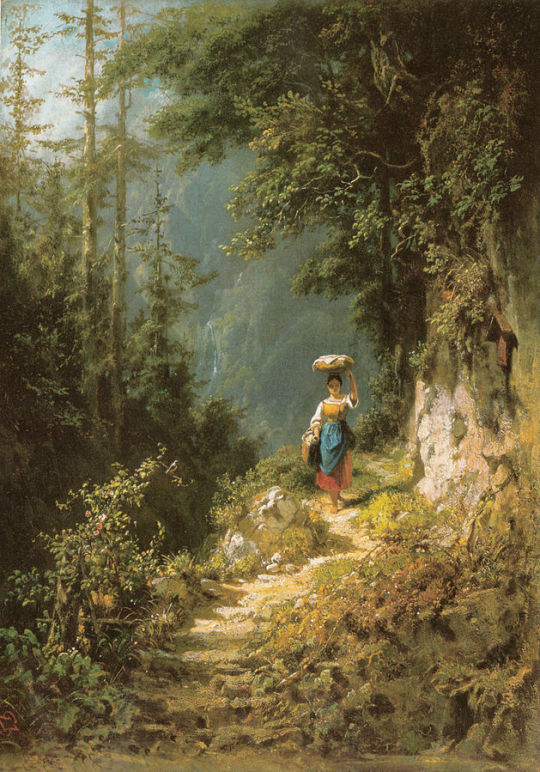
Carl Spitzweg (1808-1885)
"Girl with Headload" (c. 1860)
Oil on paper mounted on canvas
Biedermeier
Currently in a private collection
#paintings#art#artwork#genre painting#genre scene#carl spitzweg#oil on paper#fine art#biedermeier#private collection#german artist#landscape#forest#woods#clothing#clothes#female portrait#portrait of a girl#1860s#mid 1800s#mid 19th century#a queue work of art
839 notes
·
View notes
Text

The change of fashion through the years 1867-1907.
#fashion#historical#historical fashion#victorian#victorian era#victorian fashion#historical clothing#historical dress#history#long dress#1800s dress#edwardian dress#edwardian era#edwardian#19th century fashion#1900s style#1890s fashion#mid 1800s#1870s fashion#1860s fashion#the gilded age#victorian dress#fashion dress#dresses#dress#edwardian fashion#high fashion#19th century#20th century
358 notes
·
View notes
Text
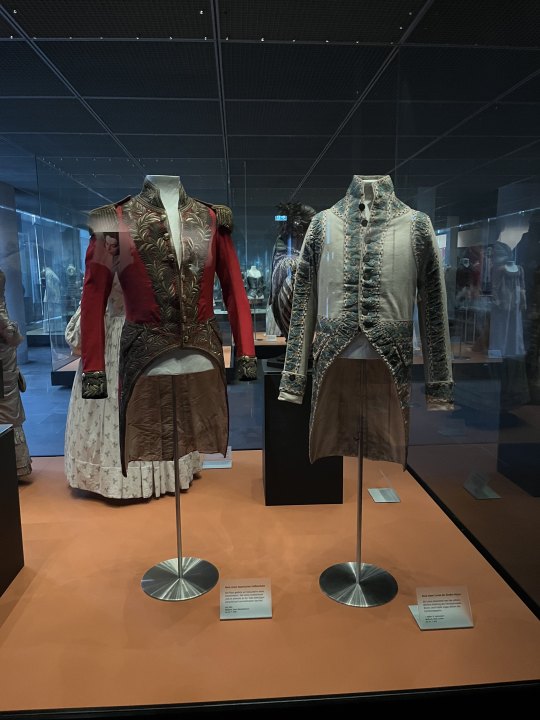
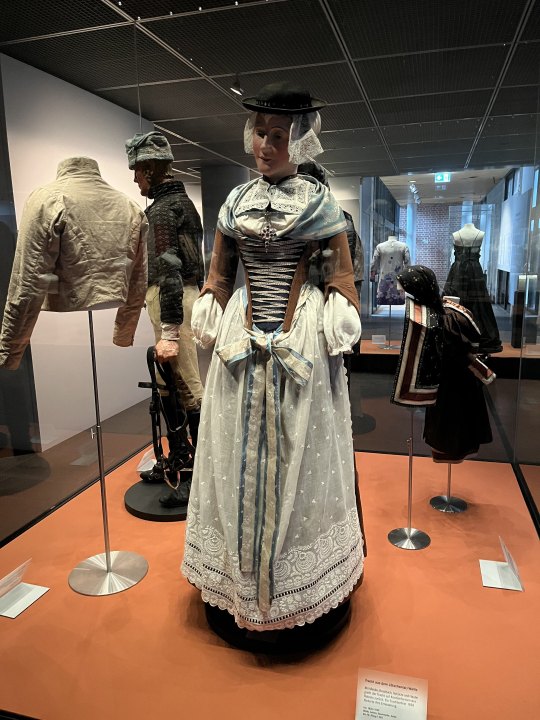

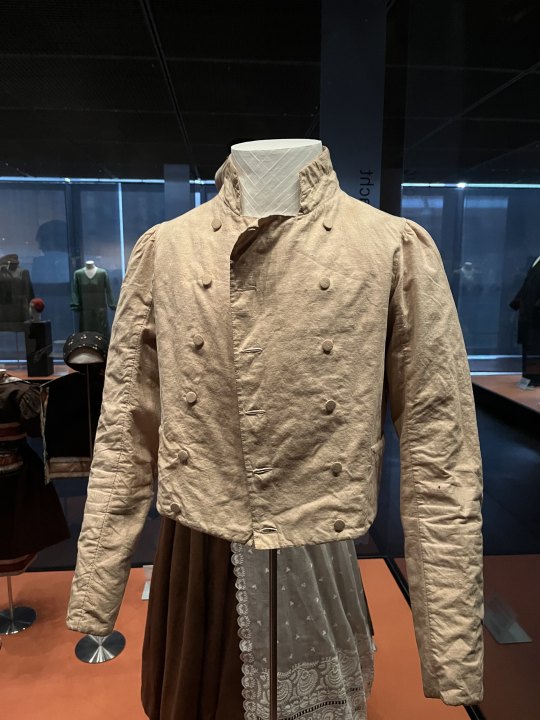
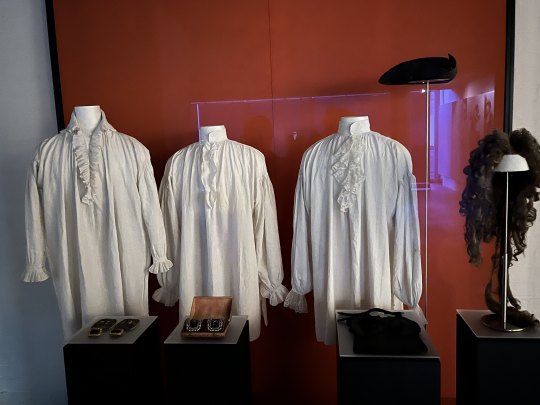



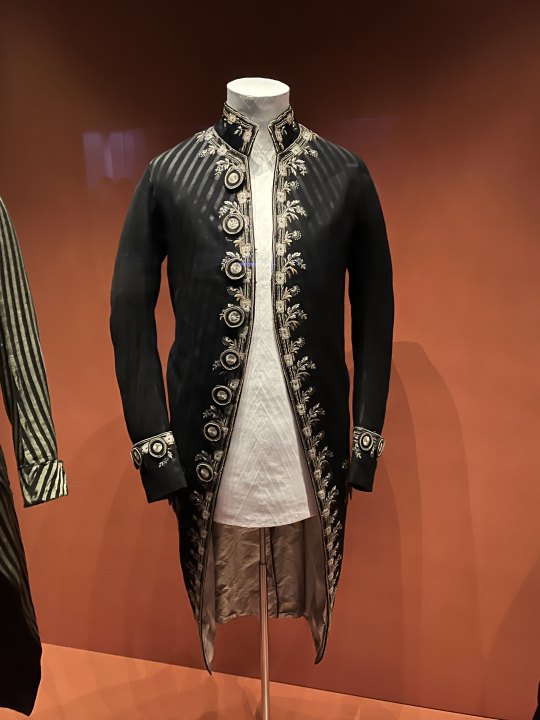

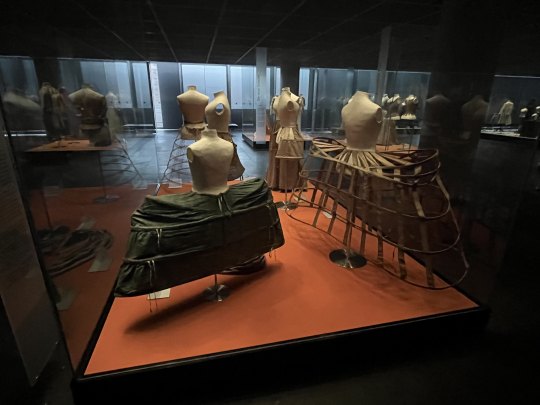
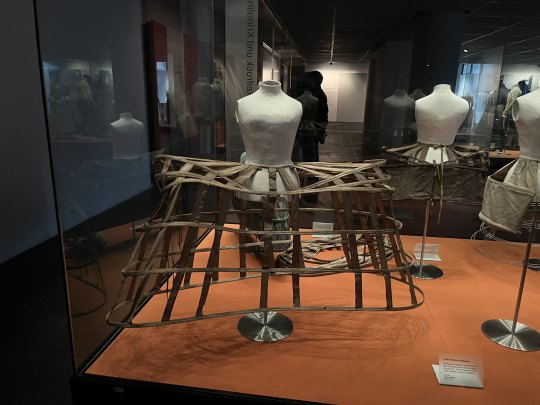
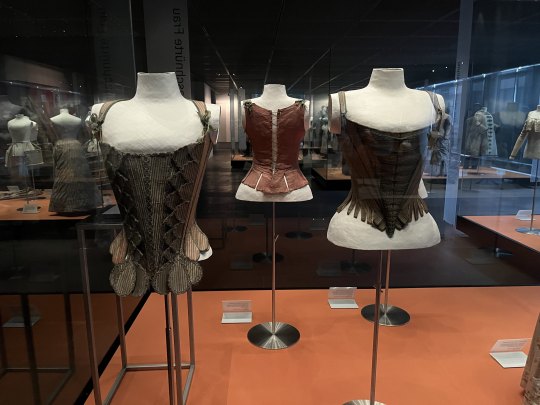

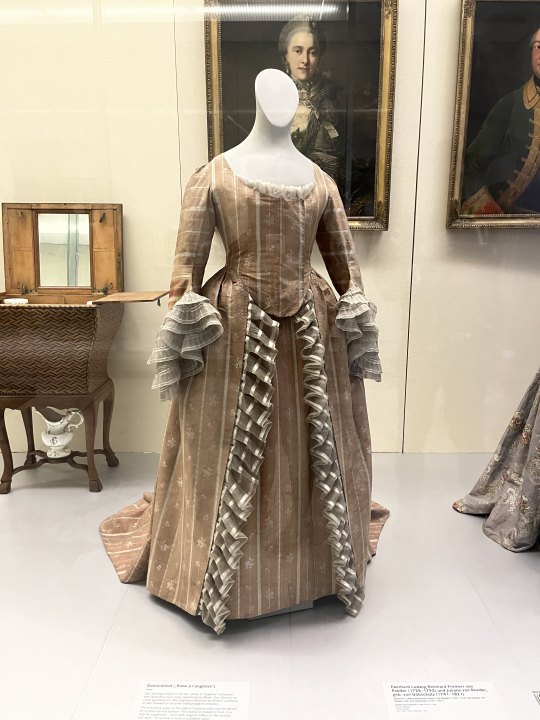
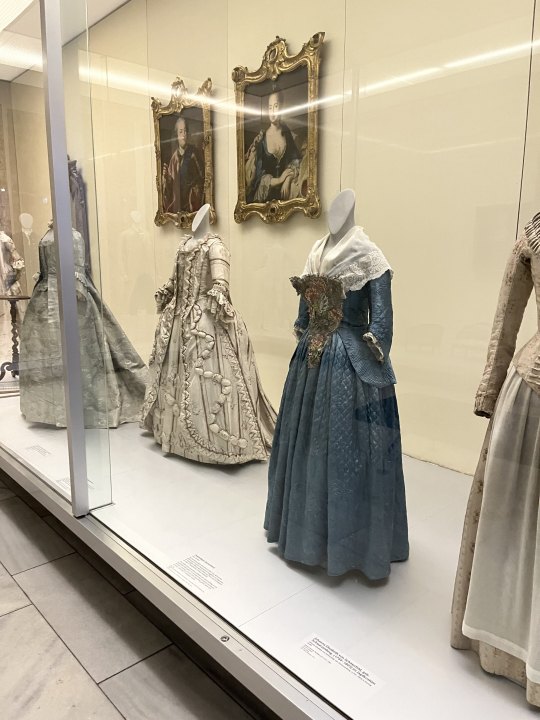
And here, as promised to the dear @vinceaddams come a lot of extant Garments from my recent Visit at the German National Museum in Nuremberg. I am trying to give as much Information about each Picture as I can though unfortunately not all of the Pictures were taken by me and I could take Pictures as extensively (including Info Signs) as I would have wanted, lest I be abandoned in the Clothing Section. Also the whole Section was awfully dim, which made it rather difficult to read some of the Signs. The last three Pictures were taken in a different Section, thus the more pleasant Lighting.
Servant Livery, bavarian Court, mid 19th Century (left); Servant of the Count of Cannotreadhisname, first half 19th Century (right)
Woman's Folkdress, Lötschental/Wallis (Switzerland), Museum dates it 1830/1905 which is an awfully broad Range, but maybe it was altered later; shows wonderfully how late 18th Century Styles were preserved in european Folkdress that came to be in the 19th Century proper
Various Men's Garments throughout the 18th Century, as there are Closeups of each, the respective Detailinformation will be provided further down.
Men's Spencer, c. 1810s-1820s, Linen and Cotton, the Sign didn't say it explicitely but due to it's Placement in the Exhibition and comparable other Pieces I have seen, I think this is more of a common Man's Piece of Clothing.
Three Men's Shirts, various Shoebuckles, a cocked Hat, a Periwig and what I assume to be a Hair Bag. This Display Case had a rather badly illuminated Sign, so sadly I have no further Details about the Pieces.
Justeaucorps, c. 1695, Wool, Silk, Metal Trim.
Waistcoat, c. 1695, Silk, according to the Museum it was worn together with the Justeaucorps, which seems to be a nice Colour-Combination.
Breeches, 1790-1800, Silk. Very pretty Pair, but the bad Lighting doesn't really let it show.
Habit à la francaise, c. 1790, Wool, Silk, Embroidery (What a Material Specification...). I really like the Combination of those subtle dark on dark Stripes and the Embroidery.
Tailcoat, c. 1790/1795, Cotton, Silk, Linen, really peak 1790s Look honestly.
Very wide Court Panniers, with Pocket Hoops and Crinoline in the Background. Alas no Detail Information for this and the next two Pictures.
Frontal View of the Pannier. I suppose I have to get one of those at some Point, if only for how extra they are.
Three Pairs of Stays, two from the Front, one from the Back. Sadly I don't feel confident enough to Date those and I have no Pictures showing the Info Signs well enough.
Lots of pretty Dresses that were exhibited in another Section of the Museum. The right one is a Robe à l'Anglaise, but that's all I can tell.
Another beautiful Anglaise, notable for being preserved in its Entirety with original Ruffles.
More pretty Dresses. Unfortunately due to Time Reasons I have no Pictures of the Suits displayed across the Dresses in the U-shaped Display, though I have to say one of them had a very much not authentic Lacebib hanging from the Neck...
That's all the cool Clothing Pics I have, at some Point I will return and take loooots more Pictures from all the Angles too. Also at some Point I might write to the Museum about the Lighting, there surely is a better Solution when having your Objects barely visible with unreadable Signs while still protecting them from UV-Rays.
Bonus-Pic 1:

Me, in historical Dress, c. 1750 (minus the Shoes), standing in a historical Kitchen.
Bonus-Pic 2, for the Boat-Crowd:
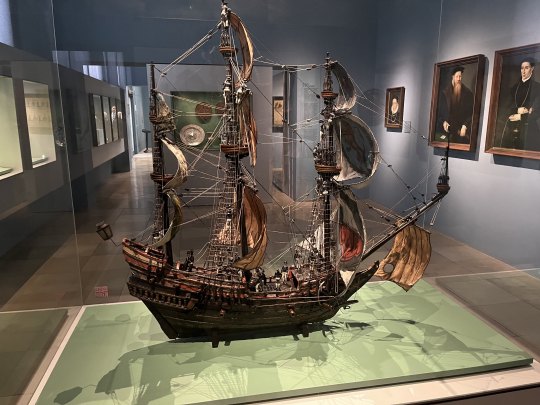
Beautifully detailed Modell Sailing Ship, early to mid 17th Century if I remember correctly. Interestingly enough all the little Sailor Figurines on it were very much early 19th Century in Style, so I assume the previous owner had those added at some Point, before the Museum acquired the Model in the late 19th Century. (The Incongruence sadly wasn't addressed on the Info Sign, so I might contact them about this too.)
#Aus dem Leben einer Taugenichts#Extant Garments#Historical Fashion#Germanisches National Museum#18th Century#19th Century#Museum
156 notes
·
View notes
Text
The non-resplendid Outfit: What poor women wore in the mid to late 1800s, Victorian era

Housemaids, early 1860’s. They are dressed in their best for the photographer, but look at their hands. From Victorian Working Women. They could perhaps have scullury maids, who were a lower ranked of housemaid.

Fig. 1 - Washerwoman and young girl • Mid-1800's

Fig. 2 - From 'Street Life in London', 1877, by John Thomson and Adolphe Smith. "The accompanying photograph represents a second-hand clothes shop in a narrow thoroughfare of St. Giles."
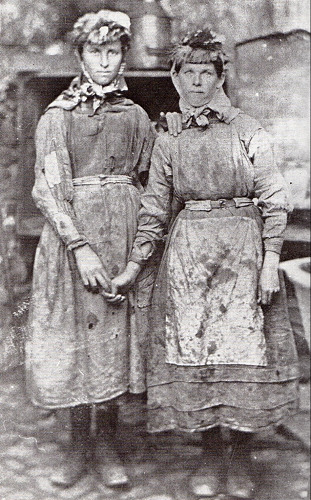
Fig. 3 - These women were referred to as "tip girls". Their job was to unload mine refuse from train cars and on to the "tip" of the mountains of mine waste. Tredegar, Wales, 1865. Photo by W. Clayton from Victorian Working Women
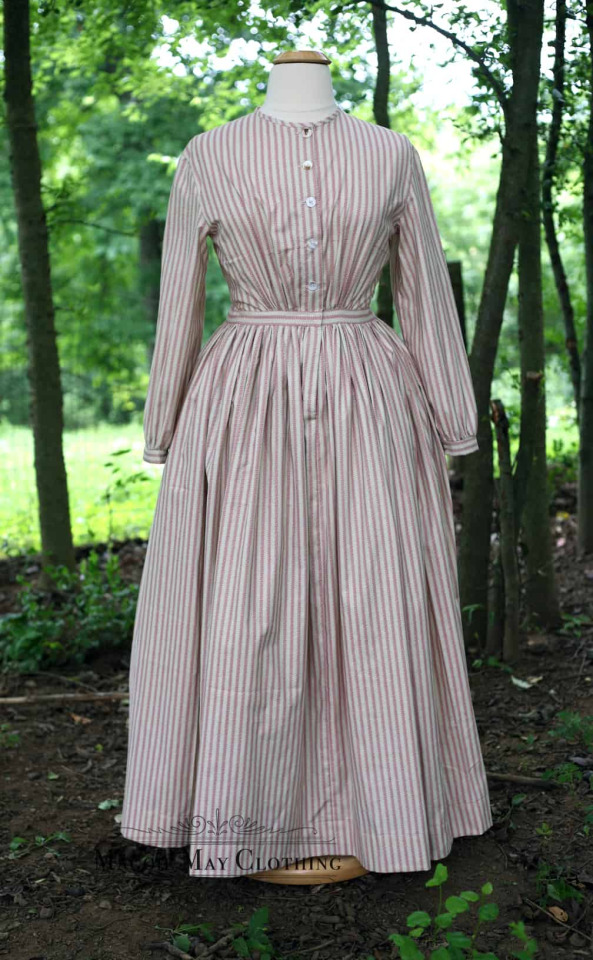
fig. 4 - This dress features a loose fitting, unlined bodice gathered gently under the bust and at the center back. The sleeves are cut moderately to encourage movement and feature a short cuff with button closure. The semi full skirt is gathered into a waistband and attached to the bodice. The skirt is hemmed to the ankle with a single turn hem. The gown closes at the center front with buttons. Shown over over a quilted petticoat and extra full petticoats. Typically worn between 1840 and 1890. This dress is a replica based on research.
Working class women in the Victorian era couldn't afford the latest fashions. They wore simple, practical clothing in a style dependent on their ooccupation. In figure 1, The woman is wearing a simple dress and cape. Her clothing looks clean because she's a washerwoman; her clothing only exposed to water and soap. Her dress is very similar to the one in figure 4.
In figure 2, the women working in the second-hand clothes shop are also performing work that isn't likely to soil their clothing. It's interesting to discover there were such shops. I always assumed poor women of this era made their own clothing.
A job such as handling coal (figure 3) was such dirty work that the clothing worn for it had to be made from thick, rough fabrics and cut loose to facilitate movement. The dirtier and more physically demanding the work, the rougher the clothing.
#fashion history#victorian era#working women#victorian work clothes#1800s women's work#victorian work dress#the resplendent outfit#victorian history#historic photographs#historic clothing#history of workers#women's history
68 notes
·
View notes
Text
A Young Person's Introduction to Late 19th-Century Western Fashion
hello fellow youths
General information
Banner, Bernadette. "Exposing Victorian Influencers Who 'Facetuned' Their Photos. (Photo Manipulation was EVERYWHERE)." YouTube. July 17, 2021.
English Heritage. "Fashion Through History: Episode 1 – Victorians." YouTube. February 9, 2023.
Lady Rebecca Fashions. "100 Years of Fashion // The Fashionable Plus Size Silhouette from 1820-1910." YouTube. June 5, 2021.
Victoria and Albert Museum. "100 Years of Fashionable Womenswear: 1830s – 1930s | V&A." YouTube. July 18, 2023.
Zebrowska, Karolina. "Victorian Fashion Is Not What You Think It Is." YouTube. March 19, 2019.
Accessories
Banner, Bernadette. ""Afro-Victorian": Bringing Historical Black Women's Dress into the 21st Century w Cheyney McKnight." YouTube. October 20, 2021.
Cox, Abby. "A Fashion Historian Explains the History of the Handbag." YouTube. January 26, 2023.
Rudolph, Nicole. "Dangerous Things in Victorian Pockets : Mens Pocket History." YouTube. March 2, 2024.
Rudolph, Nicole. "The Controversial History of Color Season Analysis." YouTube. November 4, 2023.
Zebrowska, Karolina. "Disgusting and Creepy Victorian Fashion Trends." YouTube. October 17, 2018.
Bustles and hoopskirts
Donner, Morgan. "Weirdest Victorian Invention: The Bustle-Chair (and we made one)." YouTube. November 20, 2020.
Lady Rebecca Fashions. "100 Years of Underwear // The Changing Plus Size Shape from Regency to Victorian to Edwardian." YouTube. May 1, 2021.
Lady Rebecca Fashions. "All About Bustles! A Deep Dive into 1870s Fashions." YouTube. December 26, 2023.
Rudolph, Nicole. "Why were Victorian Hips Controversial?" YouTube. September 12, 2021.
Cosmetics
Birchwood, Vasi. "1800s Makeup Is Not What You Think." YouTube. July 21, 2023.
English Heritage. "Queen Victoria Makeup Tutorial | History Inspired | Feat. Amber Butchart and Rebecca Butterworth." YouTube. May 20, 2019.
Zebrowska, Karolina. "I Used Only Victorian Cosmetics For a Week." YouTube. July 26, 2023.
Fabrics
Rudolph, Nicole. "Did Silk Spontaneously Combust in the Victorian Era?" YouTube. August 8, 2021.
Rudolph, Nicole. "The History of Elastic." YouTube. July 4, 2021.
Rudolph, Nicole. "The Truth About Arsenic in the Victorian Era." YouTube. January 24, 2021.
Gowns
Bullat, Samantha. "Dress Historian Analyzes Victorian Mourning Clothing of the Mid-19th Century." YouTube. March 14, 2021.
Lady Rebecca Fashions. "All About 1860's Fashion // What did Civil War-era fashion look like?" YouTube. November 12, 2022.
Lady Rebecca Fashions. "How did fashion evolve from 1850-1859? // 1850's Fashion Deep Dive." YouTube. October 1, 2022.
Rudolph, Nicole. "Victorian Fast Fashion? The Truth about the History of Disposable Clothing." YouTube. February 6, 2022.
SnappyDragon. "Were the Pre-Raphaelites painting accurate medieval dress . . . or Victorian fairtytalecore?" YouTube. April 26, 2024.
Zebrowska, Karolina. "19th Century Fashion - How To Tell Different Decades Apart?" YouTube. November 17, 2017.
Hair care and styling
Banner, Bernadette. "Following a Victorian Home Made Hair Care Routine (1889)." YouTube. September 11, 2021.
Lady Rebecca Fashions. "Getting Dressed in an 1888 Daisy Costume // Easy Bustle-Era Hair Tutorial." YouTube. November 13, 2020.
Lady Rebecca Fashions. "Getting Dressed in the 1870s & 1874 Hairstyle Tutorial." YouTube. February 23, 2020.
Rudolph, Nicole. "Why did Victorian Women Cut their Hair Short?" YouTube. December 18, 2022.
Laundry and housekeeping
English Heritage. "A Tour of the Laundry - The Victorian Way." YouTube. September 6, 2019.
English Heritage. "How to Wash Up - The Victorian Way." YouTube. March 18, 2021.
English Heritage. "Laying the Table at Christmas – The Victorian Way." YouTube. December 14, 2022.
Walkley, Christina, and Vanda Foster. Crinolines and Crimping Irons: Victorian Clothes: How They Were Cleaned and Cared for. Peter Owen Limited: London, 1978.
Outerwear and working wear
Birchwood, Vasi. "What Irish Working Women Wore in the Late 19th Century | I Made the Clothing of My Irish Ancestors." YouTube. June 23, 2023.
English Heritage. "The Real Mrs Crocombe | Part Four: A Victorian Cook's Outfit." YouTube. July 5, 2018.
Stowell, Lauren. "It's Hot: Let's Look At Some Bathing Suits." American Duchess. August 18, 2023.
Rudolph, Nicole. "The History of Jeans, T-shirts, and Hoodies: Time Travel 101." YouTube. March 20, 2022.
Zebrowska, Karolina. "The 1851 Women's Pants That Made The Victorians Go Crazy." YouTube. March 2, 2020.
Shoes
Rudolph, Nicole. "100 years of Antique Boots." YouTube. February 10, 2024.
Rudolph, Nicole. "How to Make Regency & Victorian Shoes: Beginner Shoemaking." YouTube. June 27, 2021.
Rudolph, Nicole. "The Myth of Tiny Feet "Back Then"." YouTube. September 26, 2021.
Undergarments
Banner, Bernadette. "I Wore a (Medical) Corset for 5 Years. How do Victorian Corsets Compare?" YouTube. November 7, 2020.
Banner, Bernadette. "Making Some Frilly Victorian Underwear || 1890s Combinations." YouTube. February 9, 2019.
Birchwood, Vasi. "What Victorians Wore to Bed." YouTube. May 5, 2023.
Cox, Abby. "I made weird Victorian underwear (it's a knit onesie) & a pretty 1890s corset || historical sewing." YouTube. March 21, 2021.
Lady Rebecca Fashions. "How 8 Different Historical Corsets Affect the Same Plus Size Body." YouTube. December 12, 2020.
Rudolph, Nicole. "100 Years of Corset History: How 8 Corsets affect the same body." YouTube. November 29, 2020.
Zebrowska, Karolina. "How Did Victorian Ladies Stay Warm in Winter? || THE EXPERIMENT." YouTube. January 22, 2021.
Zebrowska, Karolina. "How Did Victorian Women Deal With Their Periods?" YouTube. October 17, 2019.
#victorian era#history#fashion#karolina zebrowska#youtube#video#nicole rudolph#bernadette banner#abby cox#lady rebecca fashions#american duchess#shoes#hair care#hairstyle#morgan donner#1800s#1860s#us history#american history#cosmetics#gilded age#reconstruction era#1850s#1870s#menstruation#1880s#1890s#gibson girl#reference#edwardian era
69 notes
·
View notes
Text
如月 (kisaragi) “February” (archaic)

Like many countries, Japan uses a 12-month calendar. The names are very simple. January is literally "Month one" 一月, February is "Month two" 二月, etc.
However, before the Meiji Restoration (mid-1800s) it was common to use an older 12-month system. These months’ names referenced the weather and the seasons (similar to the French Revolutionary calendar).
"February" is 如月. Japanese learners will recognise the kanji 月 as "moon" or "month".
The first kanji is not common these days. It can be substituted with 衣更, which has the same sound and gives clues as to the original meaning of the month. 衣 means clothing and 更 refers to a continuing demand for something. So February is the month when it is still cold so you still need all your warm winter clothes.
This old calendar system is based on a lunar calendar with exactly 28 days in each month, beginning and ending on the new moon. An obvious disadvantage to this system is that the months don’t fit into a year exactly, and so the months will get earlier and earlier each year Every so often the calendar had to be adjusted a little.
#japanese language#japanese culture#書道#japan#japanese#japanese calligraphy#japanese art#calligraphy#kanji#japanese langblr#February
58 notes
·
View notes
Text
Queen Victoria Didn’t Popularize White Dresses
Contrary to what is regurgitated on Wikipedia and other sites, from dubiously sourced claims - Queen Victoria of England did not begin the trend of white bridal gowns.
White, cream, ivory colored gowns were common choices for brides throughout the 1700s and early 1800s, well before her marriage in 1840.
While Victoria’s bridal gown did have influence on the fashion world, the white color alone was not a major component of that.
Her choice in gown was more unusual in that it was not cloth of silver or gold, as would be customary for royal brides, rather than merely for it being white fabric. It was seen as a more simple, romantic design intended to honor her love match with Albert.
Beyond that, other colors continued to be popular choices for brides well after the 1840s- colorful gowns were not seen as unusual or scandalous until at least the mid 20th century.
The gowns below all date from the 1810s, 1820s, and 1830s- decades and years before Victoria married.
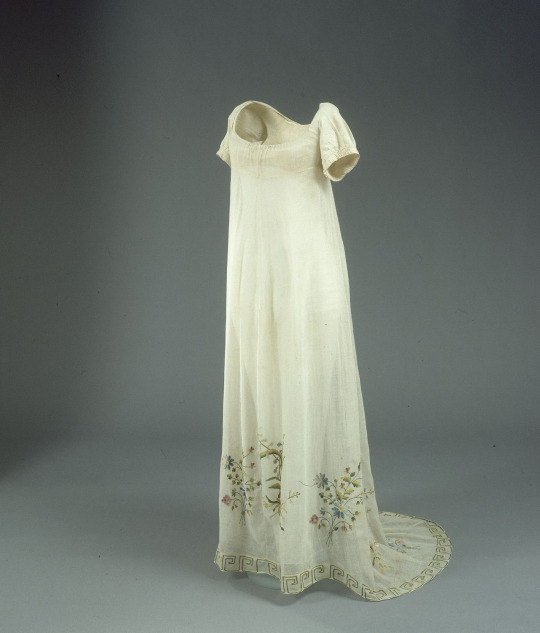

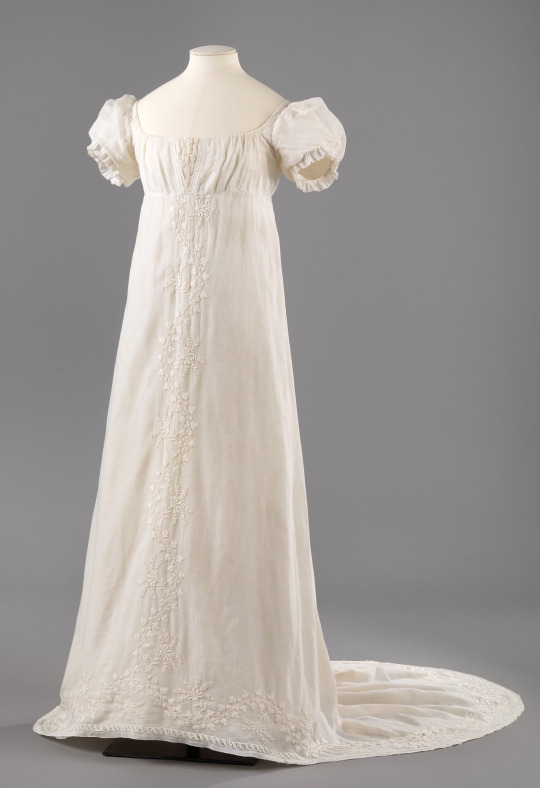
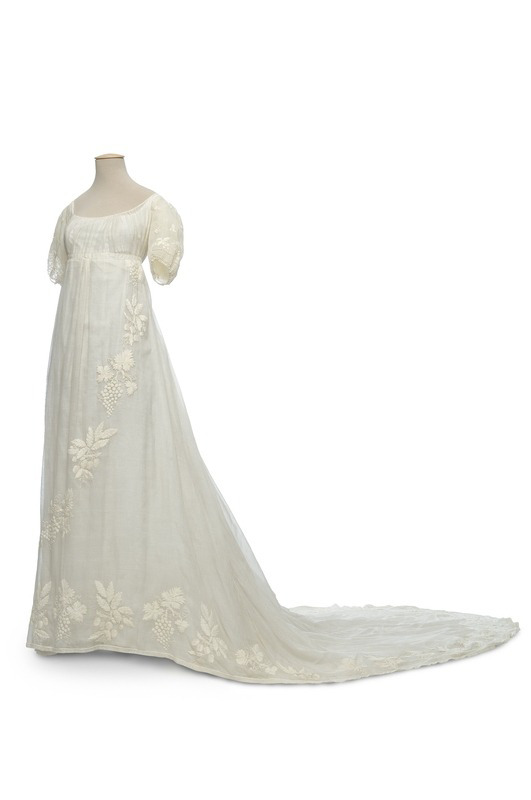

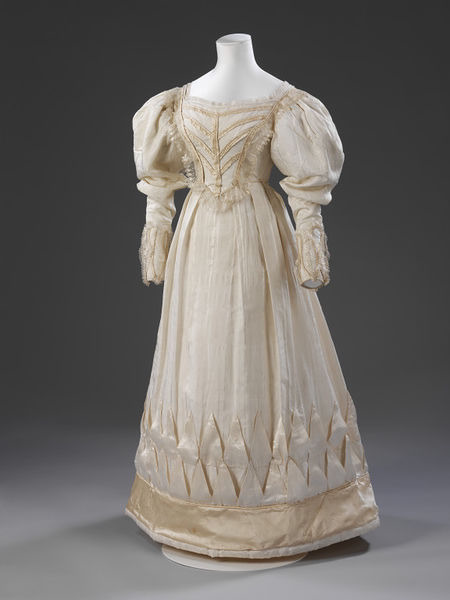
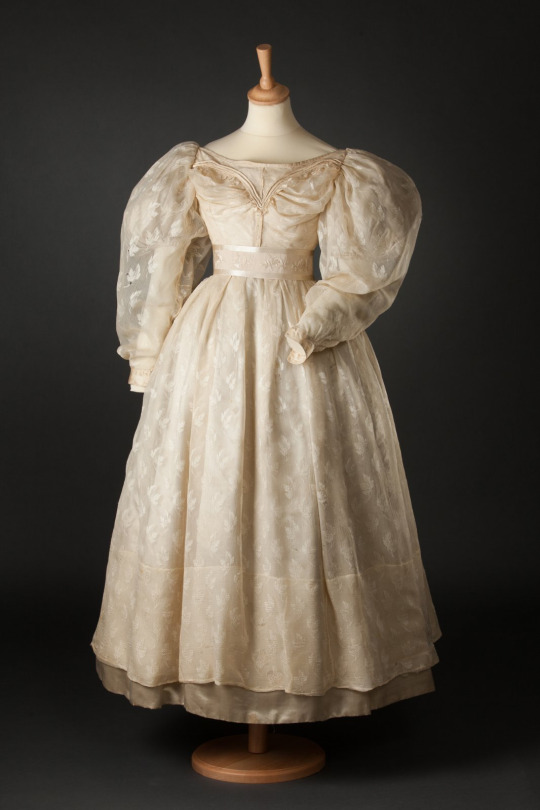

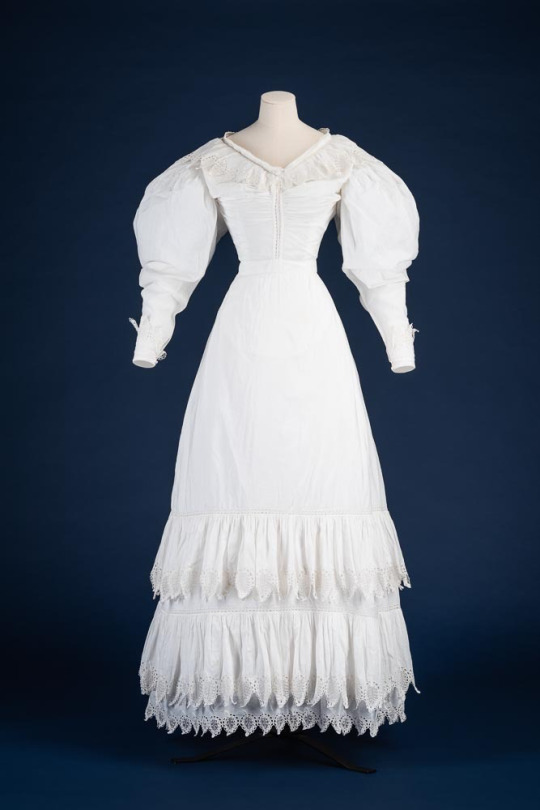
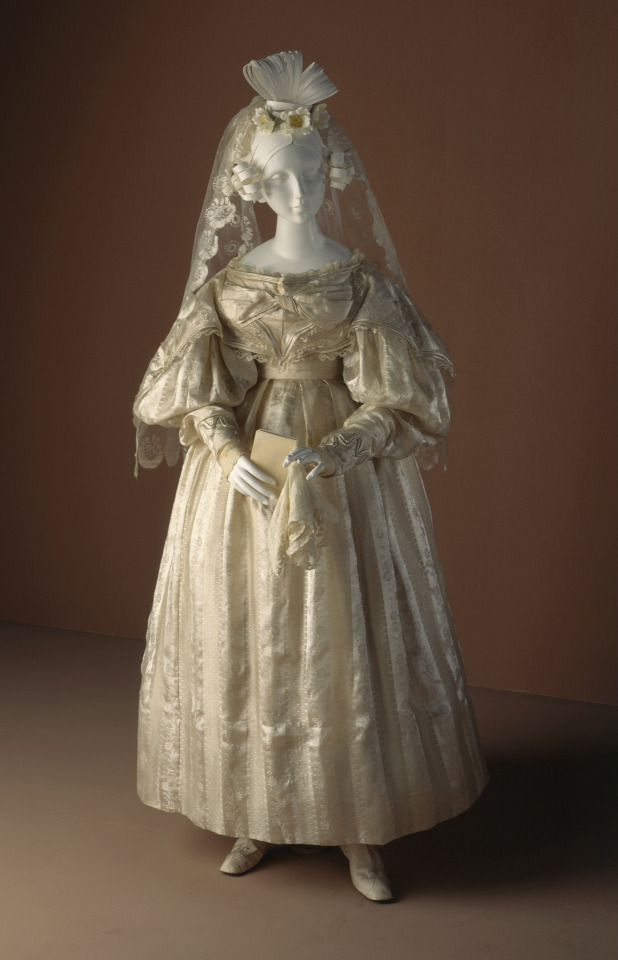
97 notes
·
View notes